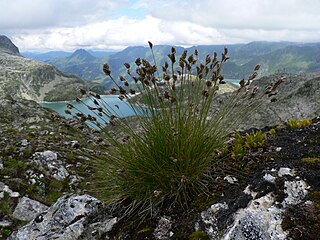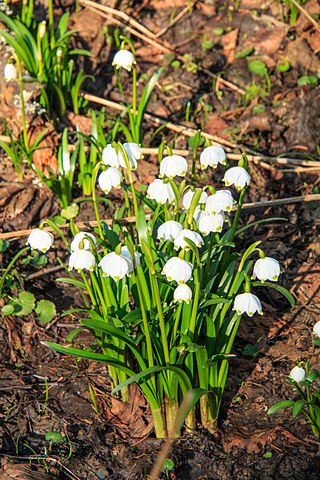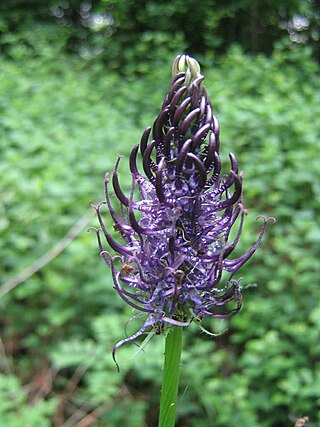
The Carpathian Mountains or Carpathians are a range of mountains forming an arc across Central Europe. Roughly 1,500 km (930 mi) long, it is the third-longest European mountain range after the Urals at 2,500 km (1,600 mi) and the Scandinavian Mountains at 1,700 km (1,100 mi). The range stretches from the far eastern Czech Republic (3%) and Austria (1%) in the northwest through Slovakia (21%), Poland (10%), Ukraine (10%), Romania (50%) to Serbia (5%) in the south. The highest range within the Carpathians is known as the Tatra mountains in Poland and Slovakia, where the highest peaks exceed 2,600 m (8,500 ft). The second-highest range is the Southern Carpathians in Romania, where the highest peaks range between 2,500 m (8,200 ft) and 2,550 m (8,370 ft).

Marrubium is a genus of flowering plants in the family Lamiaceae, native to temperate regions of Europe, North Africa, and Asia as far east as the Xinjiang region of western China. A few species are also naturalized in North and South America.

Gymnadenia is a genus of flowering plants in the orchid family (Orchidaceae) containing 22 terrestrial species. The former genus Nigritella is now included in Gymnadenia.

Campanula is the type genus of the Campanulaceae family of flowering plants. Campanula are commonly known as bellflowers and take both their common and scientific names from the bell-shaped flowers — campanula is Latin for "little bell".

The family Campanulaceae, of the order Asterales, contains nearly 2400 species in 84 genera of herbaceous plants, shrubs, and rarely small trees, often with milky sap. Among them are several familiar garden plants belonging to the genera Campanula (bellflower), Lobelia, and Platycodon (balloonflower). Campanula rapunculus and Codonopsis lanceolata are eaten as vegetables. Lobelia inflata, L. siphilitica and L. tupa and others have been used as medicinal plants. Campanula rapunculoides may be a troublesome weed, particularly in gardens, while Legousia spp. may occur in arable fields.

Rhamphospermum nigrum, black mustard, is an annual plant cultivated for its dark-brown-to-black seeds, which are commonly used as a spice. It is native to cooler regions of North Africa, temperate regions of Europe, and parts of Asia.

Campanula carpatica, the tussock bellflower or Carpathian harebell, is a species of flowering plant in the family Campanulaceae.

Phyteuma orbiculare, common name round-headed rampion or Pride of Sussex, is a herbaceous perennial plant of the genus Phyteuma belonging to the family Campanulaceae.
The European-Mediterranean montane mixed forests is a composite ecoregion of southern Europe and North Africa, designated by the World Wildlife Fund as one of their Global 200 ecoregions, a list of priority ecoregions for conservation.

Koeleria is a common and widespread genus of plants in the grass family, found on all continents except Antarctica and on various oceanic islands. It includes species known generally as Junegrasses.

Helictotrichon, or alpine oatgrass, is a genus of perennial flowering plants in the grass family. The genus name comes from the Greek heliktos meaning twisted, and trichos meaning hair, referring to the shape of the awn.

Phyteuma spicatum, the spiked rampion, is a herbaceous perennial plant in the family Campanulaceae. It is common across much of Europe. Its common names include raiponce en épi (French), Ährige Teufelskralle (German), Ährige Rapunzel, and Raponzolo giallo (Italian).

Oreochloa is a genus of European plants in the grass family.

Colchicum bulbocodium, the spring meadow saffron, is a species of alpine bulbous plant native to mountain ranges across Europe from the Pyrenees to the Caucasus.

Galeopsis is a genus of annual herbaceous plants native to Europe and Asia. Members of this genus often have common names ending in hemp-nettle or hempnettle. Some species are naturalized in North America and New Zealand.

Physoplexis comosa, the tufted horned rampion, is a species of flowering plant in the family Campanulaceae, native to alpine Europe. It is the only species in its genus, and was formerly included in Phyteuma.

Leucojum vernum, called the spring snowflake, is a species of flowering plant in the family Amaryllidaceae. It is native to central and southern Europe from Belgium to Ukraine. It is considered naturalized in north-western Europe, including Great Britain and parts of Scandinavia, and in the US states of Georgia and Florida. This spring flowering bulbous herbaceous perennial is cultivated as an ornamental for a sunny position. The plant multiplies in favourable conditions to form clumps. Each plant bears a single white flower with greenish marks near the tip of the tepal, on a stem about 10–20 cm (3.9–7.9 in) tall, occasionally more.

Phyteuma scheuchzeri, the Oxford rampion or horned rampion, is a perennial herbaceous flowering plant in the family Campanulaceae.

Phyteuma betonicifolium, common name betony-leaved rampion, is a species of flowering plant in the family Campanulaceae.

Phyteuma (P) nigrum, the black rampion, is a relatively rare species of plant in the family Campanulaceae. P. nigrum is located in central to northern Europe, primarily concentrated in Scandinavia. Much progress is yet to be made in forming concrete evolutionary relationships within this family and between the genera, but the molecular data from P. nigrum has contributed to the progress made in completing the evolutionary tree. The decrease in P. nigrum numbers over the past few decades has prompted the investigation into the reasons behind such a decline, leading to the conclusion that the factors that lead to a healthy P. nigrum population also run the risk of harming the population if not in just the right amount. The delicate nature of this organism makes its survival and reproductive success that much more uncertain.




















